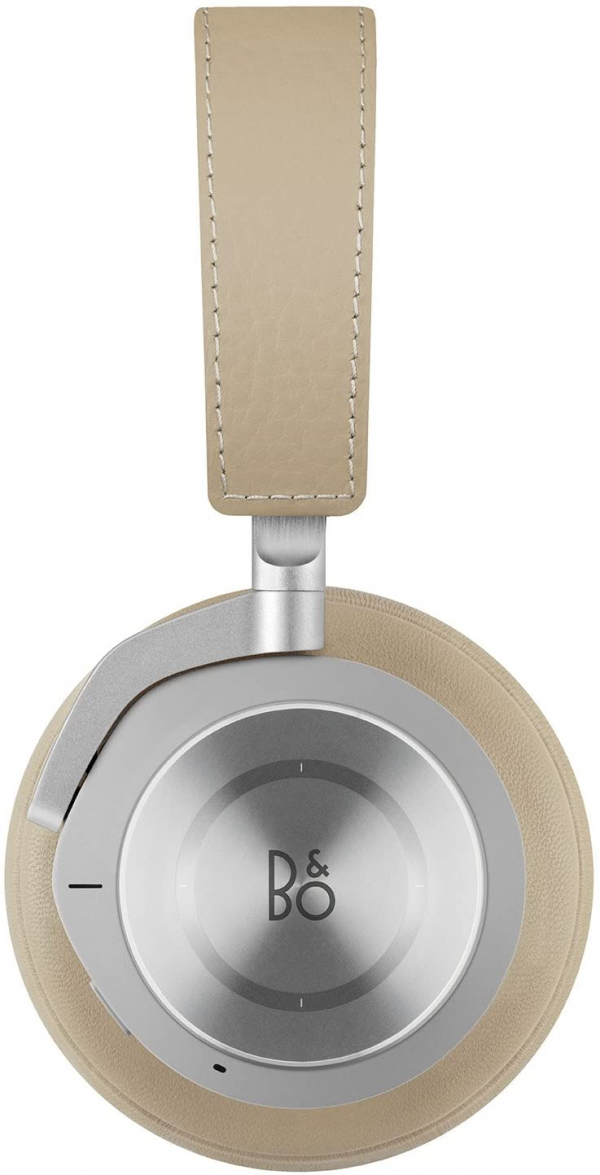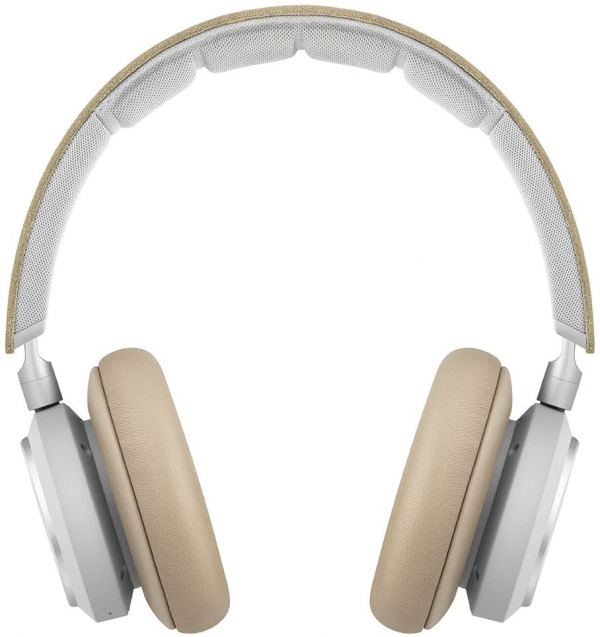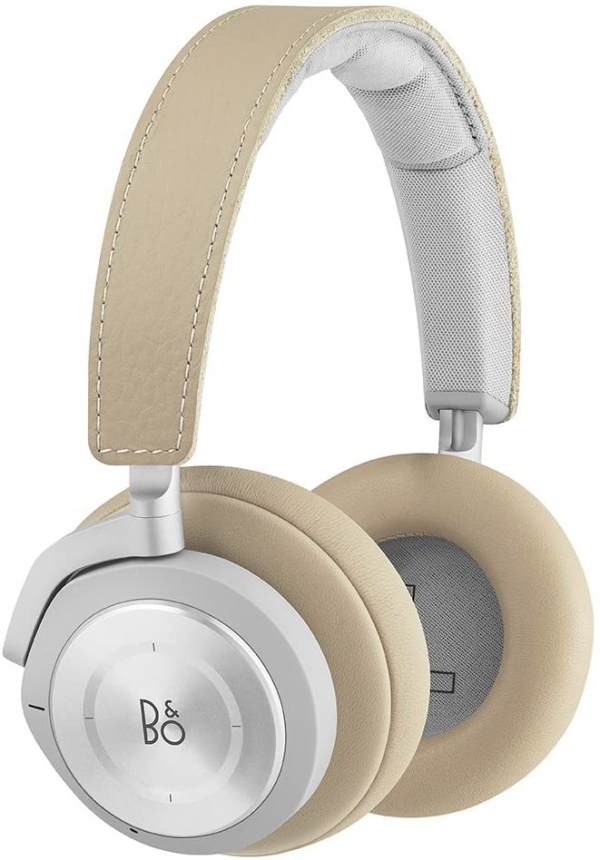BO Play
Nomadic helmet B&O Play Beoplay H9i: splendor and furious
Aprox. 324€ - see price -
More than a year after an H9 which had left us quite skeptical, B&O Play replaces its flagship models H8 and H9 with new versions. Called H9i, this portable headset with active noise reduction promises many improvements, both ergonomic (better autonomy, more efficient hands-free kit ...) and sound (active noise reduction more efficient on voices, more powerful bass ...). Are the Danish manufacturer's promises verified in practice?
Our review
Audio
B&O Play has indeed changed its approach in terms of sound reproduction on this version, but not necessarily for the better. This model still retains significant disparities in rendering between listening without and with active noise reduction. The least we can say is that the Beoplay H9i still does not do in finesse.
Frequency response measurement. Left: wired connection without active noise reduction (black) and with active noise reduction (red). Right: wireless connection without active noise reduction (blue) and with active noise reduction (black).
The differences between Beoplay H9 and H9i are played out over the first part of the spectrum. A different acoustic setting and the presence of a dedicated bass vent on each headset are certainly behind this change. However, the approach is still not subtle and the behavior of the membranes remains far from perfect. With active noise reduction on, the H9i offers a very deep response in the low frequencies, but puts too much emphasis on the bass. What is more, the very localized peak around 40 Hz strengthens the feeling of depth, pressure and bass impact too significantly.
The result is certainly very flattering, but leads to masking effects because of the lack of reactivity of the membranes on attacks: very fast and close hits of the bass drum are very good examples to note this, because they really test the membranes; the legibility of the elements operating in this area suffers. In addition, this behavior causes some hearing fatigue over long listening sessions. Without active noise reduction, this zone drops drastically, so that it ends up a little too far behind the rest of the audible spectrum. In this case, but only in Bluetooth, the EQ of the application can compensate for this drop. On the other hand, there is nothing that can be done on the reactivity side of the membranes.
Frequency response measurement. Left: EQ correction (green) on sound rendering without active noise reduction (black). Right: EQ correction (green) on sound rendering with active noise reduction (black).
Sound coloring is also required on the second part of the spectrum. With the active noise reduction engaged, we obtain a signature in W with a small fairly localized highlighting of the mids and a very marked and extremely localized boost (our measure tends to boost this last peak a little, but it is clearly audible here). This combination leads to both a significant increase in the presence and impact of many sources (presence and intelligibility of the voice, attack of percussion, pinching or friction on string instruments, etc.), as well as the appearance brilliant, metallic treble (harmonics of saturated guitars, cymbals, whistling voices).
This coloring is less important, softer and ultimately less tiring when the noise reduction is not engaged. Unfortunately, the dull mediums and some sources seem more dull. In wireless, whether with or without RBA, the EQ cannot save furniture. The only thing you can do is to come to calm the bass and soften the mid / treble by moving the slider in the “Relaxed” part when the active noise reduction is engaged.
What about stereophony? In this look, the Beoplay H9i behaves like its predecessor. The scene unfolds quite widely and, if not the compactness of the bass, we can identify without too much difficulty the different elements that compose it.
On the side of active noise reduction, the improvement promised between 300 Hz and 800 Hz is significant, but it is there. We have dedicated a complete news to this subject, which we invite you to consult if you want to know more.
The Beoplay H9i made a small leap forward in the field of distortion. Without active noise reduction, the distortion is calm across the entire audible spectrum. This is less the case when activating noise reduction, especially in midrange. You can especially feel it when you turn up the listening volume to a fairly sustained level, which can cause a bit of aggressiveness in high mids. In all cases, the distortion in the extreme low / low has disappeared, and fortunately given the sound reproduction reserved for this zone.
The H9i has also gained in sensitivity. You will still have no problem propelling it with a portable device since it only requires 135 mVrms to reach 94 dB SPL in wired connection without active noise reduction and 95 mVrms to reach the same threshold in wired connection with reduction of active noise.
Regarding the latency of wireless communication, these headphones are in the middle of what can be found on the market. The result is not as impressive as with the previous model, but it is still suitable for watching video content without being too disturbed by the sound / image lag. If your reading allows, however, do not hesitate to compensate.

Conclusion
Even with its evolutions, it is difficult for the H9i to establish itself in the closed circle of wireless headsets with active noise reduction. Direct competition is very tough, especially with such an introductory price (€ 499). We clearly prefer the Sony WH-1000XM2, the QC 35 or even the QC 35 II, whether for comfort or sound performance. In addition, these models are more really more accessible in terms of price. There is therefore no reason to hesitate.

Reviews


Super good sound out of the B&O units (UPDATED 21 APRIL 2018)
I compared these headphones to Bose Quietcomfort 35 ii and Bowers & Wilkins PX over five days of use. I plan to keep the B & Os and have since returned the Bose and B&W. I may change the rating to five stars, once the factory resolves a minor issue.
B&O H9i wins on several fronts, but the B&W PX are a very-very close second. Super good sound out of the B&W units.
The B&O H9i definitely have better comfort for extended wearing. The B&O can accept audio input via bluetooth, a USB-C cable from a computer, or a 3.5mm Stereo Jack. This is a must for me since I use a host of audio inputs from various sources.
The B&O phone app allows modification of the sound of the headphones via a very basic EQ. Its a basic app, but as a very tech savvy mechanical engineer, sound geek, drummer, and mixer operator in a large church, I would like to see such an app for a high end set of headphones have more capability. I really wish companies would make an app that allows a fully parametric EQ interface, similar to an App called EQu (by elephantcandy) for the IPhone. The right earphone allows the user to interface with the phone when listening to music. You can stop, skip, backup songs, turn on and off noise cancellation, and turn on off a “talk through” feature that allows outside sounds to come through so you don't have to take the headphones off to listen to your environment. Follow the manufacturer's directions carefully, it takes just a little bit of care getting used to but it works fine.
The noise cancellation is excellent. I have used the headphones around the house, while on airplanes, driving, and a work in an office. Very solid noise cancellation. I typically listen to acid jazz, contemporary jazz, modern jazz / rock music at lower volumes. When I take the headphones off I am amazed at how loud everything is and how well the noise cancellation works. It totally eliminates the noise of riding in a car or an airplane.
The sound of music with noise cancellation and without noise cancellation is noticeably different. More midrange tones are present without noise cancellation, although careful tweaking of the B&O interface app can accommodate this. The app allows you to save presets so that you can set the phone EQ to account for when noise cancellation is on or off.
Only negative (temporarily I am told) is that when using only a 3.5mm stereo input connection to the headphones, the sound quality is terrible compared to using bluetooth or USB-C connections. This is the case with or without the power switch turned on, and with or without the noise cancellation turned on. I knew this could not be correct and there was nothing in the instructions or website that identified this. I corresponded with the factory a few times by phone and email regarding the poor sound quality on only the 3.5mm stereo cable connections. As of 6 April the factory reps (Nancy and Ivan) indicated that my issue with the sound quality change when using only a 3.5mm connection is not an isolated incident. The factory rep Ivan told me the factory is planning to issue a firmware update to try to resolve the problem. I asked if the problem is not resolved via firmware I wanted to return the headphones and get a replacement pair that do not suffer from this problem. Ivan said that would not be a problem since I have established a case # via email.
UPDATED APRIL 21, 2018:
The latest update of the app for the smart phone changed the sound of the headphones when using ONLY the 3.5mm cable. Seems as though the fix is in and the headphones sound as good.
Buggy firmware
Very good audio quality coming from iphone 7 plus via bluetooth, I love B&O products. This h9i I gave 3 stars because at the beginning all sensors proximity works 99%, but then I got the latest firmware upgrade to this 5.0.4 if I'm not wrong, suddenly the right earcup only respond to play / pause. All other gestures such as from bottom to up (transparency mode), from up to bottom (NC on / off), left to right, right to left (next / previous) not working at all! (I tried to reset the headphone to its factory mode already) And the worst is the B&O support said that I got defect product. How could it be it is defect if at the start it's working, but when it's firmware's upgraded become lagged. Please give us additional firmware upgrade B&O (if you read this).
Loved Everything But Comfort
I also own the Bose QC 35II and felt these were better in every regard except comfort. The way these fit over my ears caused discomfort in less than 30 minutes. It's too bad because these were at least as good in noise cancellation, if not better, sounded better and better features but the Bose were more comfortable. If you have larger ears these may not be for you.
Stunning. Immersive. Comfortable. Gorgeous. Must-Own.
Having owned these headphones for a few weeks, all I can say about them is, WOW.
As an owner of Bowers & Wilkins H7's (and loving them with truly mad love) for the past several years and a pair of Beoplay H6's, I feel like I'm in a good position to give an opinion about the transition from more traditional wired cans into the H9i's.
First, let's start with construction, materials and design. In this realm, Bang & Olufsen has created a masterpiece. My Bowers & Wilkins H7's are also magnificently constructed, so if you know this model, I can vouch for them being as meticulously beautiful and robust as the B & W's. I fully expect these headphones to last for years.
Comfort is fantastic. The ear pads are incredibly plush and ridiculously comfortable. Opening the box and literally smelling leather like a fine pair of shoes was an indication of the fact that these are ultra-premium headphones. Contrast that with the faux leather of, say, Bose. I've owned a pair in the past and I can assure you that the plastic and faux leather will not wear well. In this regard, the H9i is well worth the additional money.
Sonically, the H9i is wonderfully neutral. The ability to tailor the sonic signature via the app is fantastic. Not only can you choose the right mix of warm / relaxed / excited / bright, but by pinching the "dot" in the app, you can also adjust separation to give the sound the kind of air and space you'd like. Brilliantly executed.
The touch controls on the earpiece are fantastic. Don't let peoples' comments about them being fussy deter you. Once you've had them for 48 hours you'll be able to do whatever you want pretty much flawlessly.
Noise cancellation is solid and achieved with minimal air pressure sensation. The transparency mode makes the H9i ideal for use in an office environment. I think I've freaked people out by swiping up and having a normal conversation without taking off my headphones. ;)
Overall, I literally couldn't be more pleased with my purchase. Once again, Bang & Olufsen has done an amazing job. This is my fourth Beoplay purchase. Based on the H9i's, it certainly won't be my last.
Horrible design and interfacing. Features glich. DO NOT BUY!
These are horrible headphones. Noise cancellation not that good mainly because of style of "over ear" design doesn't cover ear properly. If you turn your head it pauses your music or video. So many thing caused random pauses constantly. It was awful. Finally and the worst part is they were so uncomfortable on ears and top of head. Couldn't wear for more than two hour and had to stop for a few hours. Which the whole reason i get them is for long flights. DO NOT BUY